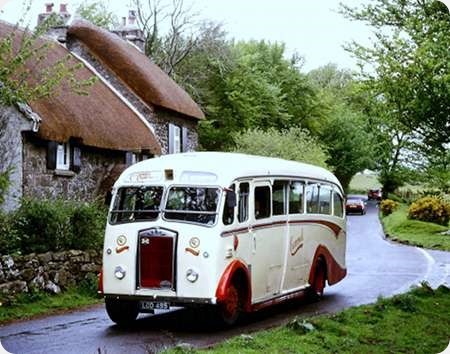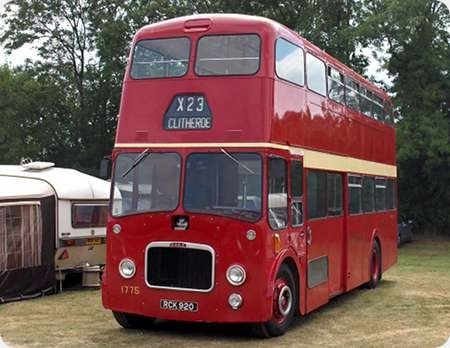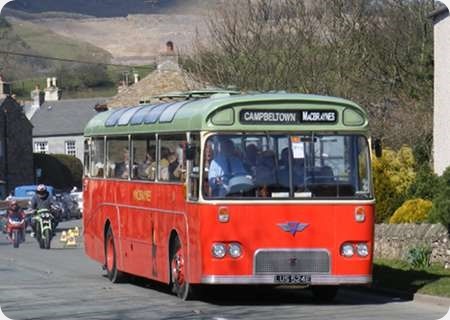Carmel Coaches – Albion Victor – LOD 495
Carmel Coaches
1950
Albion Victor
Duple C??F
As there appears to be no picture of this lovely coach on OBP , I am attaching one. It has been in preservation for many years with Carmel Coaches of Northlew in Devon and can still be seen at local events in the West Country. It was for a while used on Dartmoor Summer Sunday services connecting with trains – and other bus services – at the then newly restored Southern Region station at Okehampton. Initially the route was the 174 to Moretonhampstead where it met the cross Dartmoor 82 between Exeter and Plymouth. For a couple of glorious summers, the 174 was extended onto Widecombe in the Moor using some very narrow lanes. The Albion coped well with the lanes and the hills including the very steep one into Widecombe. One difficulty was with other traffic as visitors and indeed locals seemed to be unable/unwilling to reverse their vehicles in these lanes. This became a major problem when the Pony Club had their occasional meet on the Moor as their exodus with large vehicles or trailers – all at the same time – coincided with the last journey from Widecombe which had to connect with the said 82 and the last train at Okehampton. The owner of the Albion, who was the regular drive on almost every Summer Sunday over the years, was always patient and courteous and I am grateful to him for the opportunities to ride the coach.
The photo is taken at Hound Tor before the steep descent into Widecombe.
Photograph and Copy contributed by Keith Newton
28/08/17 – 10:12
This is a Victor FT39N powered by the Albion 75 bhp 4.88 litre four cylinder diesel engine that was delivered new to Way of Crediton in 1950. I believe that the gearbox is a five speed constant mesh unit. Nowhere can I find the stated capacity of the Duple bodywork, but this was usually 31 or 33.
Roger Cox
29/08/17 – 06:36
Roger,
My 1993 edition of Preserved Buses, Trolleys and Trams gives LOD 495 as an FT39AN with a Duple FC31F body.
Dave Farrier
30/08/17 – 07:57
Thanks for that confirmation about the bodywork, Dave. As for the chassis designation, this is FT39AN as you state, but it was often shortened with the ‘A’ omitted. Why? I don’t know, or indeed what the letter itself stood for. The final ‘N’ indicated the "normal" 16ft wheelbase, the longer 16ft 11ins version having the letter ‘L’ instead. The ‘A’ cannot have indicated an initial variant because the post 1956 versions became the FT39KAN and KAL. Perhaps it indicated forward control, but I know of no normal control examples. I have to admit that the some of the (pre Leyland) Albion company’s type numbering seemed to have no logical basis that I can discover. The initial Viking/Valkyrie/Valiant/Victor were classified as PA/PB/PC etc up to PW which clearly meant successive passenger variants. Then came the Venturer M81 and the Valorous M85, which were superseded in 1937 by the Valkyrie and Venturer CX. After WW2 the Victor name reappeared as the FT as seen above, contemporary with Valiant/Viking/Venturer models all classified CX, and the KP underfloor model. Then under Leyland ownership came the Nlmbus MR9 and the Aberdonian MR11, though the latter had no design similarity with the shorter Nimbus, being essentially a lighter weight version of the Tiger Cub. Then some degree of logic returned with NS for Nimbus (again with AN suffix), LR for Lowlander, VT for Victor, VK for Viking, before the Albion name disappeared forever. (Another firm with puzzling model designations was Thornycroft, but that is by the way.)
Roger Cox
31/08/17 – 04:56
At risk of seeming foolish, did the A stand for Albion (engine)? Valorous belongs to the Wulfrunian school of bus naming & then Valkyrie? With whole dictionaries to go at!
I’ll stick, BMW/Mercedes style with CVD6 and K6A!
Joe
01/09/17 – 05:48
Possibly, Joe, but why didn’t the contemporary Albion engined Venturer CX19 and CX37, Valiant CX39, Viking CX41 (a variant of which was called the HD61 – again why?) and the experimental KP71NW have the ‘A’ also? The numbers, always odds rather than evens, seem to have had some sequential logic albeit with gaps, though the number 39 was duplicated for the Victor and Valiant models. Perhaps Bletchley Park could come up with the answers to the Albion nomenclature.
Roger Cox
01/09/17 – 05:49
In John Gillham’s book "Buses and Coaches 1945-1965", he says that the FT 39 Victor was introduced in early 1947, and that a modified version, known as the "FT 39 AN" appeared at the end of 1951, with the long wheelbase "FT 39 AL" following some three years later. The same thing happened to the Nimbus in 1960, when the NS3N was replaced by the NS3AN.
I take this to mean that the A was just a spec-update marker, rather as Leyland would later use it on PSU3A (and on to G), AN68A etc.
Graham Woods
01/09/17 – 05:50
Roger, according to definitive book ‘Albion of Scotstoun’ (Adama & Milligan) the ‘A’ suffix indicated improvements to the previous version, including a larger wormwheel assembly on the rear axle, improved braking, heavier springs, flexible radiator tubes, improved fuel filtration and minor wheelbase alterations. The insertion of the ‘K’ before the ‘A’ indicated a later variant fitted with the larger EN287 5.5 litre engine (replacing the EN286 4.88 litre unit) and heavier front springs.
John Stringer
01/09/17 – 15:19
Thank you Graham and John. That explanation does make sense. Back in its vastly superior days when Classic Bus was under Gavin Booth’s editorship it included a series of comprehensive articles on the history of the Albion passenger ranges by Alan Townsin. Sadly I gave all my copies away after being totally disenchanted with the magazine’s altered and self obsessed guise under subsequent editors. I remain rather baffled by the type letters of the heavier Albion models which all, passenger and haulage, seem to have been classified CX. In addition to the Venturer CX19 and 37, the Valiant CX39 and the Viking CX 41, there were the CX1 7 tonner, CX3 6½ tonner, CX5 12 tonner six wheeler and CX7 eight wheeler 14½ tonner. The FT3 code included a haulage version for 4 to 5 ton loads and one suspects that the straight framed FT39 Victor was a simple derivative from it. This webpage gives a list of some pre 1945 Albion types, though it is far from comprehensive in detail:- www.autogallery.org.ru/m/albion.htm
Roger Cox
02/09/17 – 08:08
Sorry to dive off the main subject but I just want to say how much I agree with Roger about Classic Bus magazine. Totally ruined by the Best Impressions outfit and a total rip-off based on the lack of content and acres of empty space on the pages. I have lapsed my subscription in disgust.
There I feel better now!
Philip Halstead
02/09/17 – 08:54
Interesting comment on Classic Bus as I feel it has gone the other way and improved enormously making it more readable and not just for the anorak which is where Gavin (an extremely knowledgeable guy) was taking it.
Best forgotten is the editor in-between.
Even if I am not totally in agreement with the content I still keep my subscriptions going as if we lose the magazines Bus & Coach History and reach to the public will be diminished and ultimately it makes the movement more fragmented
Roger Burdett
27/11/21 – 06:22
Researching this vehicle again it is pretty certainly a FT39N model of 1950, 25ft 6 ins chassis length. The engine is certainly the 4.88 litre EN 286, but the gearbox is a four speed constant mesh unit. The brakes were vacuum servo. The FT39AN, which appeared in 1951, had the engine moved forward a bit and the rear overhang extended slightly enabling 33 seats to be accommodated within the bodywork.
Roger Cox
Quick links to the - Comments Page - Contact Page - Home Page



